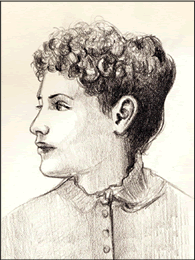Math Challenge
Choose your grade level:
Elementary School
Middle School
High School
Video & Photos
September 2008
A Salute to the Troops Game Video
July 2008
All-Star Tee Ball Game Video
All-Star Tee Ball Game Photo Essay
June 2008
Eighth Season Opener Video
Eighth Season Opener Photo Essay
March 2008
White House Easter Egg Roll 2008
December 2007
Barney Cam VI: Holiday in the Parks
December 2007
Barney Cam VI Photo Essay
June 2007
Tee Ball on the South Lawn Photos

 White House Dream Team: Henry Tan
ner
White House Dream Team: Henry Tan
ner
|
As a child, Anne Sullivan experienced many difficulties. At age five an illness left her nearly blind, and her mother died a few years later. Abandoned by their father, Anne and her brother were sent to live in an orphanage. Anne longed to go to school like other children and learn to read. An inspector visiting the institution heard of Anne's desire to attend school, and he sent her to the Perkins Institution for the Blind in Boston, Massachusetts. Through the instruction of several teachers, Anne learned to read using Braille and she developed social skills. She graduated first in her class in 1880, and surgery restored some of her sight. After graduation, Anne traveled to Tuscumbia, Alabama in 1887 to become the teacher and caretaker of six-year-old Helen Keller, who was unable to see, hear or speak because of an illness. Helen's behavior was out of control and the only way she communicated was through touch. Anne used creativity, discipline, patience and persistence to teach Helen that "everything had a name." Through Anne's early persistence, Helen developed a vocabulary and demonstrated an ability to learn. Anne accompanied Helen to several schools, including her own school, Perkins Institution. As a young adult, Helen passed the same college entrance exam taken by other students and began classes at Radcliffe College in 1900. Anne attended class with Helen and spelled-out the lectures for her. She also taught Helen to read using the Braille system and to write using a special typewriter. Helen graduated with honors from Radcliffe in 1904. Anne married a Harvard professor named John Macy in 1905, and Helen lived with them in Boston. Helen became a lecturer and author, and Anne accompanied Helen on her worldwide tours. The pair even created an entertainment routine in which Anne would explain Helen's achievements, and then Helen would speak and make a few humorous remarks. She and Helen also helped to raise funds for the American Foundation for the Blind. Anne's teaching success and Helen's accomplishments gained national attention, including a visit to the White House to meet First Lady Grace Coolidge, who was a former teacher of deaf children. Anne's own health declined, however, and by 1935 she was completely blind. She died in 1936. Years after Anne's death in 1955, Helen wrote a book about Anne, and called it simply, Teacher. Because of Anne's teaching success, Helen's private life and public career helped many Americans understand that people with disabilities could live productive, successful lives. Brain Challenge:
Want to learn more? |
Born April 14, 1866 in Feeding Hills, Massachusetts Died October 20, 1936 Dream To go to school School Perkins Institute for the Blind Legacy Teaching Helen Keller, who proved to the world that she had overcome her disabilities Character trait Patience Baseball Players Jackie Robinson Roberto Clemente Lou Gehrig Athletes Red Grange Jesse Owens Wilma Rudolph Patriots Samuel Adams Esther De Berdt Reed Lemuel Haynes Teachers Mary Jane McLeod Bethune Américo Paredes Anne Sullivan Macy Founders John Jay Clara Barton Booker T. Washington Authors Laura Ingalls Wilder Theodor Seuss Geisel Elwyn Brooks White More Artists Henry Tanner Gilbert Stuart Mary Cassatt |


 Anne Sullivan Macy
Anne Sullivan Macy